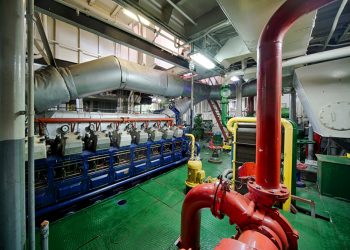The evolution of modern marine propulsion plants nowadays has resulted in a high level of machinery’s automated functioning. This has led shipping companies to continue investing in innovative technologies, adopting tested ones, and therefore reducing the number of personnel occupied with the engine room and other machinery spaces on board.
Reducing the operating personnel of those spaces, however, signals the subsequent necessity of the introduction of enhanced safety regulations. Their purpose is to fill the safety void emerged from the intentional lack of the human element that eventually leads to periodically unmanned engine rooms.
It is worth noting that ships should not be operated in Unattended Machinery Spaces (UMS) mode without an appropriate valid endorsement on the ship’s Certificate of Class. Furthermore, UMS operations are prohibited without the prior authorization of the Master.
Actions prior operating in UMS status
The SMS should include the period for Normal UMS Operations. The most common period for such operations is from 17:00 – 08:00. The reason is that normally all work, such as maintenance, stops at 17:00 and starts again at 08:00 the next morning.
Prior to commencing UMS operation, the proper functioning of the following is checked and verified:
- Chief Engineer and Duty Engineer cabin extension alarm.
- Bridge extension alarm.
- Dead Man alarm (if applicable)
Before starting the UMS operation, a series of checks should be conducted. Therefore, prior switching from manned to unmanned engine room, the relevant checklist should be used for checking and completion. This should be part of SMS and followed in any case.
According to the ICS Engine Room Procedure Guide, the most common areas to be covered are the following:
- Complete engine room round
- Machinery check (including peripheral machinery) for Main engine, Steering gear, Auxiliary engines, Auxiliary boilers, Emergency generator, Air compressors, Purifiers, Pumps, Engine on bridge control with settings as per chief engineer’s instructions
- Water, Lubricants, Fuel, Air appropriate filling levels
- Special Machinery (Acetylene and oxygen mains shut and line drained, Welding and other workshop equipment off and secured)
- Overflow lines, sludge tanks and bilges
- Alarms, Shutdowns, E/R monitoring system, Fire Detection system
Actions during UMS Operations
In order to start the UMS operation, the following actions should be conducted:
- Bridge informed about intention to go UMS
- Raise an alarm & check that bridge and cabin alarm panels are activated
- Engine Room has adequate lighting
- Engine room clear of all crew
- All entrances to engine room closed and locked
- Any irregularities or abnormal observations to be reported to chief engineer and recorded in the log book
The UMS procedure in SMS should include the periods for inspection rounds by Duty Engineer during the UMS period. The inspection round is required for verification of the status of working equipment and systems.
Most Common periods for Inspection rounds of Engineer on Duty during UMS are:
- Between 18:00-19:00 hours
- Between 22:00-24:00 hours
- Between 06:00-08:00 hours
- Any other time at the Duty Engineer’s discretion and as per C/E’s additional standing orders or night orders, if applicable.
The time of inspection should be recorded in the Engine Log Book.
However, entering in UMS Engine room is subject under a specific procedure which should be also included in SMS. Prior to the Duty Engineer entering the machinery space for a round of inspection during a UMS period, contact must be established with the bridge Officer of the Watch (OOW).
Each person entering the machinery spaces alone must:
- Inform the bridge OOW of his presence
- Report to the bridge OOW by telephone at intervals, not exceeding 15 minutes, or utilize the dead man alarm facility if fitted
- Inform the bridge OOW on departure from the engine room that the vessel had resumed UMS operation.
- Check that the access used to enter the UMS E/R is locked.
Emergencies during UMS Operation of Engine Room
In case of emergency in E/R during UMS operation, if all alarms work as appropriate, the alarm warning will be identified from Bridge Monitoring Console and by the Duty Engineer who is on duty at the time of emergency.
Depending on the emergency, actions from Emergency Response Plan of the vessel should be activated following the alarm and engaging all related personnel. The most important issue is that during UMS all access points of E/R are locked so, during the emergency one of the first actions is to establish free access to the area of the emergency.
From UMS to Manned Operation
When the period of UMS operation is terminated, the Engineer Officer of the watch, prior assuming duties, should check all related machinery/systems for appropriate functioning. Communication with the bridge is important in order everyone in both control points of the ships (Bridge / Engine room) to be in the same page on the status of machinery equipment and systems and mostly the status and control of working engines (Main and auxiliary).
UMS operation of Engine Room is a first step to Automation. However, this operation is totally controlled by humans and requires intervention and supervision to be safe.
In general, the working environment in the Engine Room is quite challenging and the performance of engine crew can be increased during working hours if they minimize their presence within the Engine Room area during watch hours and keep a controlled monitoring from a distance.


































































